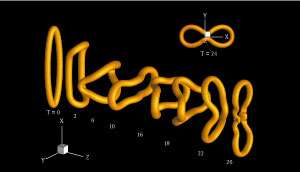Computer simulations can now show how elliptical vortex rings form

Understanding how smoke rings form and dissipate could lead to technology allowing airplanes to soar more efficiently and blood to flow more freely through the human heart.
Smoke rings or the airflows surrounding airplanes are two examples of vortex rings, which occur when a fast moving fluid—liquid or air—flows within a slower moving environment. As this faster fluid slows down at the fringes, whirls are created that start to develop into stable vortex rings.
Previously thought too complicated to solve, A*STAR researchers have now developed a computational model to simulate the motion of an elliptical vortex ring in a slow-moving fluid in a range of different situations, allowing for a more realistic description of vortex rings.
Vortex rings present issues in fields such as engineering as they can hamper fluid flow, and, for example, increase the fuel consumption of a car by reducing its aerodynamic efficiency. Understanding the formation of vortex rings under different circumstances is therefore important to improve the mass flow in fluidic devices and around moving vehicles. Previous studies on vortex rings have focused mainly on perfectly circular structures, as they are much easier to mathematically model than the more common and realistic elliptical ones, explains Cheng Ming from the A*STAR Institute of High Performance Computing (IHPC).
This challenge did not deter Cheng and the IHPC team. To investigate elliptical vortex rings, the researchers used a simulation technique called the Lattice Boltzmann Method, which divides space into a lattice of co-ordinates and calculates the particle flow for each set of co-ordinates individually. This approach is often used to model large and complex systems, such as those in weather forecasts.
The simulations allow for a detailed study of the evolution of vortex rings as they move through space, and the shape changes that the rings undergo (see image). For example, the computer model can determine the aspect ratio for which a vortex ring breaks into sub rings, and show how, after encountering a flow of mass against it, the ring is deformed and tilts as it moves further downstream. Effects like this are often the cause of aerodynamic turbulence affecting vehicles and airplanes.
"This study not only fills the gap in the current knowledge of the dynamics of an elliptic vortex ring," says Cheng, "but also addresses the issue of whether an elliptic ring undergoes vortex stretching and compression during axis-switching, which is important for various applications."
These applications can include biomedical devices to improve blood flow in the heart.
More information: M. Cheng et al. Evolution of an elliptic vortex ring in a viscous fluid, Physics of Fluids (2016). DOI: 10.1063/1.4944059
Journal information: Physics of Fluids





















